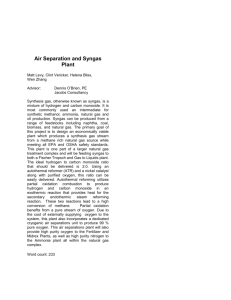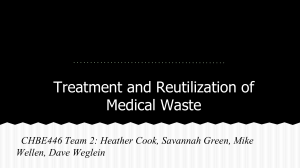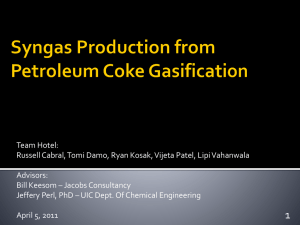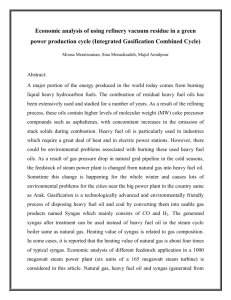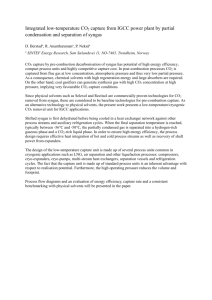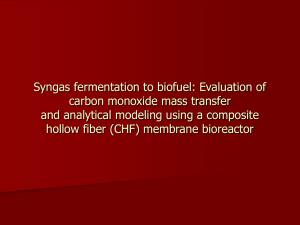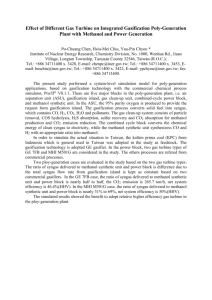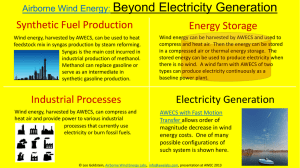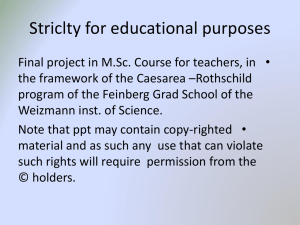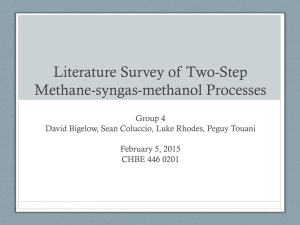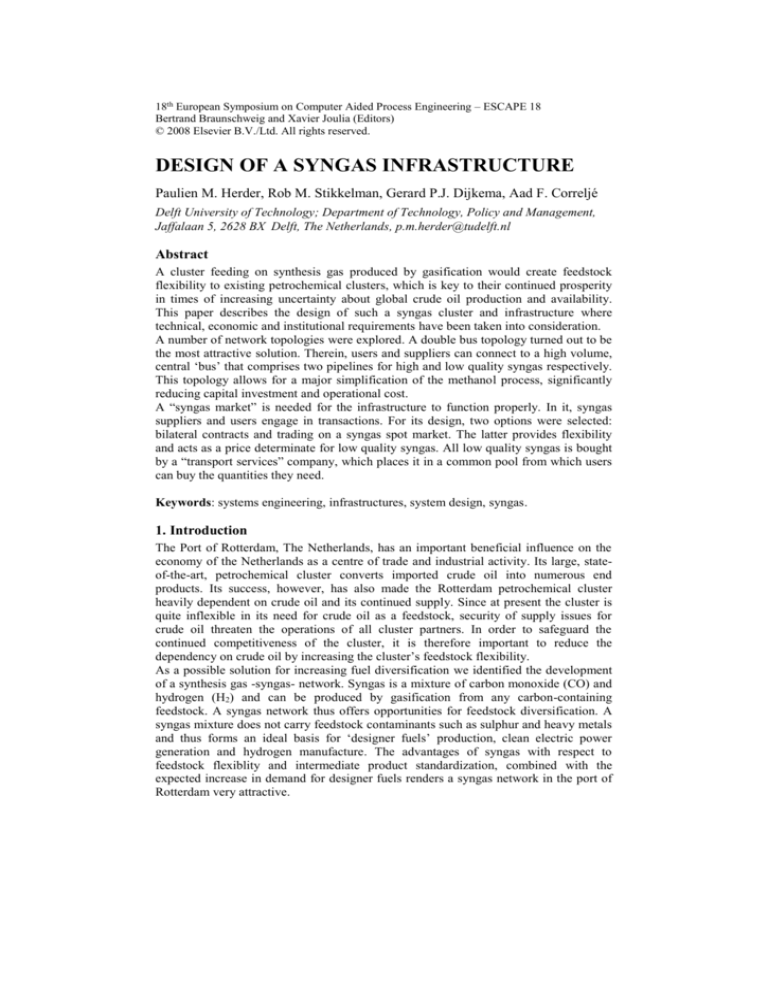
18th European Symposium on Computer Aided Process Engineering – ESCAPE 18
Bertrand Braunschweig and Xavier Joulia (Editors)
© 2008 Elsevier B.V./Ltd. All rights reserved.
DESIGN OF A SYNGAS INFRASTRUCTURE
Paulien M. Herder, Rob M. Stikkelman, Gerard P.J. Dijkema, Aad F. Correljé
Delft University of Technology; Department of Technology, Policy and Management,
Jaffalaan 5, 2628 BX Delft, The Netherlands, p.m.herder@tudelft.nl
Abstract
A cluster feeding on synthesis gas produced by gasification would create feedstock
flexibility to existing petrochemical clusters, which is key to their continued prosperity
in times of increasing uncertainty about global crude oil production and availability.
This paper describes the design of such a syngas cluster and infrastructure where
technical, economic and institutional requirements have been taken into consideration.
A number of network topologies were explored. A double bus topology turned out to be
the most attractive solution. Therein, users and suppliers can connect to a high volume,
central ‘bus’ that comprises two pipelines for high and low quality syngas respectively.
This topology allows for a major simplification of the methanol process, significantly
reducing capital investment and operational cost.
A “syngas market” is needed for the infrastructure to function properly. In it, syngas
suppliers and users engage in transactions. For its design, two options were selected:
bilateral contracts and trading on a syngas spot market. The latter provides flexibility
and acts as a price determinate for low quality syngas. All low quality syngas is bought
by a “transport services” company, which places it in a common pool from which users
can buy the quantities they need.
Keywords: systems engineering, infrastructures, system design, syngas.
1. Introduction
The Port of Rotterdam, The Netherlands, has an important beneficial influence on the
economy of the Netherlands as a centre of trade and industrial activity. Its large, stateof-the-art, petrochemical cluster converts imported crude oil into numerous end
products. Its success, however, has also made the Rotterdam petrochemical cluster
heavily dependent on crude oil and its continued supply. Since at present the cluster is
quite inflexible in its need for crude oil as a feedstock, security of supply issues for
crude oil threaten the operations of all cluster partners. In order to safeguard the
continued competitiveness of the cluster, it is therefore important to reduce the
dependency on crude oil by increasing the cluster’s feedstock flexibility.
As a possible solution for increasing fuel diversification we identified the development
of a synthesis gas -syngas- network. Syngas is a mixture of carbon monoxide (CO) and
hydrogen (H2) and can be produced by gasification from any carbon-containing
feedstock. A syngas network thus offers opportunities for feedstock diversification. A
syngas mixture does not carry feedstock contaminants such as sulphur and heavy metals
and thus forms an ideal basis for ‘designer fuels’ production, clean electric power
generation and hydrogen manufacture. The advantages of syngas with respect to
feedstock flexiblity and intermediate product standardization, combined with the
expected increase in demand for designer fuels renders a syngas network in the port of
Rotterdam very attractive.
2
P.M. Herder et al.
However, the design and implementation of a syngas infrastructure in an existing
petrochemical cluster is a complicated task where multiple interests have to be catered
for. Structural changes will be necessary for the energy and (petro-) chemical industry
to allow successful introduction of a syngas network, not to mention the large capital
investment required.
The research reported in this paper focused on the design of a syngas cluster and
infrastructure taking into account technical, economic and institutional requirements.
The design approach was based upon an architecture paradigm [1]: “An adequate
system architecture description must cover whatever aspects of cost, behavior,
performance, organization, physical structure or other elements that need to be added to
clarify the clients’ priorities.”
2. The petrochemical and energy cluster
The current energy infrastructure in the Netherlands (see figure 1) can be characterised
as rigid and inflexible. For decades, capital-intensive units such as power stations and
oil refineries have converted one specific type of fossil resource into only a few
products: most coal is converted into electric power, some 90% of crude oil is turned
into transport fuels and natural gas is used to generate electric power and heat. At a
short term a feedstock change cannot be realized for any of the facilities in this energy
infrastructure. Long-term feedstock modification options are limited and often
prohibitively expensive.
Source
38% crude oil
Conversion
Refinery
11% coal
0,8% biomass
Customer
Automotive Fuel
28% Transport
Petrochemicals
Coal-fired IPP
0,4% residues
47% natural gas
Product
Gas/fuel oil
Heat
Gas-fired IPP
27% Industry
Gas
0% Water
0,3% Wind
Turbine
1,0% Uranium
Nuclear IPP
Electricity
45% services/
households
Figure 1. Overview of the current Dutch energy infrastructure (IPP = Independent Power Plant).
Meanwhile, it remains uncertain what the ideal or available energy resources mix for the
Netherlands will be in 2020, in 2010, in 2008 or even next month. It may thus be
strategically vital that this national energy infrastructure be made independent of
specific feedstock. Rather than making a series of changes based upon the whims of the
day, we suggest a long-term fundamental shift - to deliberately change our energy
infrastructure so that it has feedstock flexibility in 2030 and 2050. This shift can be
realised via a gradual transition, wherein over a period of 30-40 years the current oil
Design of a Syngas Infrastructure
3
refineries and power stations are replaced by a multi-fuel syngas cluster and
infrastructure (see figure 2). This consists of a distribution network of:
Large, but flexible multi-fuel gasifiers that produce syngas of various qualities from
various feedstock,
units to refine syngas to set specifications, and
industrial processes which convert syngas into useable products, electric power and
heat.
Source
Conversion
Product
Design fuel
Crude oil
Coal
Customer
Transport
Petrochemicals
Biomass
Multi fuel gasifier
Syngas complex
Residues
Heat
Natural gas
Industry
Gas
Water
Wind
Flexibility
Uranium
Turbine
Electricity
Services/
Households
Nuclear IPP
Multi usability
Figure 2. The proposed Dutch energy infrastructure, 2040.
3. Technical Design
One of the main degrees-of-freedom in the design of the syngas cluster and
infrastructure is the network topology. In the design process, ring, star and bus network
configurations were considered. The evaluation of options was underpinned by
straightforward mass and energy balance calculations.
The most attractive option turned out to be a ‘double bus’ network. Therein, one of the
main syngas pipelines is reserved for syngas of “high quality” - syngas with low H2/CO
ratio within a tight range. Such HQ syngas may originate from several gasifiers.
The HQ pipeline syngas quality specification, the H2/CO ratio, must be sufficiently low
to ensure that the users that require the highest quality syngas can be served. In this
way, high CO content takes preference, which obviates the need for expensive
decentralized cryogenic separation. Users that require syngas with a higher H2/CO
ration could simply use the water gas shift reaction to increase H2 content.
The most likely syngas consumers in the infrastructure are Fisher-Tropsch diesel
processes, ammonia producers, methanol producers and the Direct Reduction of Iron
(DRI) process. The H2/CO ratios required by these process range from >0.68–4.4.
Assuming that syngas is produced using entrained flow reactors with reformers,
preliminary economic evaluation revealed that the HQ pipeline should provide syngas
in a ratio bandwidth of 0.9–1.1.
In case several gasifiers are connected to the network, each may produce syngas of a
different quality, as long as their joint product in the pipeline remains within the given
4
P.M. Herder et al.
bandwidth, which provideds leeway to cope with temporary maintenance shutdowns of
individual gasifiers.
A second pipeline network (LQ, Low Quality) must be developed to allow collection
and transport of syngas generated in downstream production processes and to allow for
flexibility of syngas quality at end-user point. The LQ pipeline network has a variable
syngas quality, which is inadequate for some chemical processes but inconsequential or
even beneficial for facilities such as electricity production and DRI [2]. The double bus
infrastructure is illustrated in figure 3.
Figure 3. A double bus infrastructure
There are several reasons for building a second pipeline: first, valuable recycle flows
can be efficiently transported to downstream users who would not mind the variable
ratio and concentration of inert gases. Thereby, in upstream industrial processes the
need for recycle equipment ceases to exist. The upstream producers could generate
some income by selling their recycle flows.
Secondly, in the upstream industrial processes one would not have to re-use flows they
normally recycle. As a consequence, the design of such processes can be simplified. A
methanol plant, for example, would fit perfectly in such an industrial cluster [3].
Currently, a methanol plant typically consists of a gasification section, a reactor section
with a large recycle loop, and a distillation section (see figure 4a). When connected to a
double bus syngas infrastructure, a methanol plant would be reduced to a reactor section
and a (slightly adapted) distillation section, without the syngas recycle system, as
illustrated in figure 4b. The elimination of the recycle equipment would lead to
significant cost reductions in the investment and operational cost of the plant.
Conversely, 40% of the raw syngas will be relegated to syngas with another ratio and
can be sold to the LQ market (see next section).
Design of a Syngas Infrastructure
5
a) Conventional methanol process design (after Wesselingh et al., 1990)
air
furnace
CO2
CH4
CO / H2
Q
CH4
reactor
reformer
H2O
MeOH
condensator
distillation
H2O
b) Methanol process design in syngas infrastructure
LQ Pipeline
HQ Pipeline
CO / H2
CO / H2
reactor
condensator
MeOH
distillation
H2O
Figure 4. Conventional (a) and new (b) methanol process design.
4. Market Design
Presently, the institution “syngas market” does not exist. In the double-bus topology
there are three dominant aspects in the design of such a market [4-6]: two types of
transactions – trading high quality and low quality syngas respectively - and a network
fee must be paid for transport services. As outlined in the technical design, in the double
bus topology two pipeline networks operate adjacent to each other. Users of the high
quality gas are allowed to feed their residue gas into the secondary network. In addition
to these recycle flows from industries that use HQ syngas, LQ syngas is directly fed into
the secondary network from gasification installations. To coordinate and balance the
process of supply and demand over two networks a new organisation must be created,
which role resembles the role of balancing organisations in the electricity and gas
sectors. This organisation is responsible for balancing both networks through a market
based balancing mechanism.
Figure 5 presents the structure of the markets and transactions. As outlined in the
technical design, the users of high quality syngas can eliminate their recycle stream to
act as a supplier for the lower quality network. The HQ users have used the high COcontent syngas and deliver a mixture with a higher hydrogen concentration to the LQ
network, and receive a price for their LQ syngas.
6
P.M. Herder et al.
Figure 5. Syngas market design
5. Conclusion
An industrial infrastructure based on syngas is a viable answer to the increasing
uncertainty in petrochemical and energy feedstock supply. It provides feedstock
flexibility through a double-bus network that connects several gasification units. It
provides syngas as a multi-functional building block for the downstream chemical and
energy industries. The design of these industrial processes may be simplified to a large
extent, provided that a syngas market is created similar to the natural gas and electricity
markets to allow syngas trade and system load balancing.
Acknowledgements
The authors would like to thank Diederik Apotheker, Dirk-Jan van der Elst, Marinda
Gaillard, Marlies van den Heuvel, and Wouter van Lelyveld for their creative and hard
work in exploring the syngas network topologies and market structures.
References
1. Maier, M.W., Rechting E. (2000), The Art of Systems Architecting, CRC Press, Inc. Boca
Raton, FL, USA
2. Herder, P.M., Stikkelman R.M. (2004), Methanol-based Industrial cluster design: a study
of the design options and design process, in Ind. Eng. Chem. Res, 43, p3879-3885
3. Energy solution centre (2007), Direct reduction: process description
http://www.energysolutionscenter.org/HeatTreat/MetalsAdvisor/iron_and_steel/process_de
scriptions/raw_metals_preparation/ironmaking/direct_reduction/ironmaking_direct_reducti
on_process_desscription.htm (accessed 24/01/2007)
4. Koppenjan, J. & Groenewegen, J. (2005) ´Institutional design for complex technological
systems´, Int. J. Technology, Policy and Management, Vol. 5,No. 3, pp. 240-257.
5. Joskow, P.L. (2003), Electricity sector restructuring and competition: Lessons learned,
http://web.mit.edu/ceepr/www/2003-014.pdf (accessed 23/01/2007)
6. Bruin, H.de, Dicke W., (2006) Strategies for Safeguarding public values in liberalized
utility sectors, in Public Administration, Vol. 84 No. 3.

